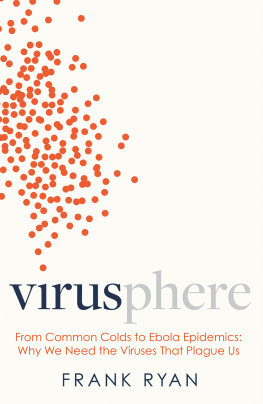
The Evolution and Emergence of RNA Viruses
Oxford Series in Ecology and Evolution Edited by Paul H. Harvey and Robert M. May
The Comparative Method in Evolutionary Biology
Paul H. Harvey and Mark D. Pagel
The Cause of Molecular Evolution
John H. Gillespie
Dunnock Behaviour and Social Evolution
N. B. Davies
Natural Selection: Domains, Levels, and Challenges
George C. Williams
Behaviour and Social Evolution of Wasps: The Communal Aggregation Hypothesis Yosiaki It
Life History Invariants: Some Explorations of Symmetry in Evolutionary Ecology Eric L. Charnov
Quantitative Ecology and the Brown Trout
J. M. Elliott
Sexual Selection and the Barn Swallow
Anders Pape Mller
Ecology and Evolution in Anoxic Worlds
Tom Fenchel and Bland J. Finlay
Anolis Lizards of the Caribbean: Ecology, Evolution and Plate Tectonics Jonathan Roughgarden
From Individual Behaviour to Population Ecology
William J. Sutherland
Evolution of Social Insect Colonies: Sex Allocation and Kin Selection Ross H. Crozier and Pekka Pamilo
Biological Invasions: Theory and Practice
Nanako Shigesada and Kohkichi Kawasaki
Cooperation Among Animals: An Evolutionary Perspective Lee Alan Dugatkin
Natural Hybridization and Evolution
Michael L. Arnold
Evolution of Sibling Rivalry
Douglas Mock and Geoffrey Parker
Asymmetry, Developmental Stability, and Evolution
Anders Pape Mller and John P. Swaddle
Metapopulation Ecology
Ilkka Hanski
Dynamic State Variable Models in Ecology: Methods and Applications Colin W. Clark and Marc Mangel
The Origin, Expansion, and Demise of Plant Species
Donald A. Levin
The Spatial and Temporal Dynamics of Host-Parasitoid Interactions Michael P. Hassell
The Ecology of Adaptive Radiation
Dolph Schluter
Parasites and the Behavior of Animals
Janice Moore
Evolutionary Ecology of Birds
Peter Bennett and Ian Owens
The Role of Chromosomal Change in Plant Evolution
Donald A. Levin
Living in Groups
Jens Krause and Graeme Ruxton
Stochastic Population Dynamics in Ecology and Conservation Russell Lande, Steiner Engen and Bernt-Erik Sther The Structure and Dynamics of Geographic Ranges
Kevin J. Gaston
Animal Signals
John Maynard Smith and David Harper
Evolutionary Ecology: The Trinidadian Guppy
Anne E. Magurran
Infectious Diseases in Primates
Charles L. Nunn and Sonia M. Altizer
Computational Molecular Evolution
Ziheng Yang
The Evolution and Emergence of RNA Viruses
Edward C. Holmes
The Evolution and
Emergence of RNA
Viruses
EDWARD C. HOLMES
Center for Infectious Disease Dynamics,
Department of Biology, The Pennsylvania State University,Pennsylvania, USA and Fogarty International Center,National Institutes of Health, Bethesda, USA
Great Clarendon Street, Oxford OX2 6DP
Oxford University Press is a department of the University of Oxford.
It furthers the Universitys objective of excellence in research, scholarship, and education by publishing worldwide in
Oxford New York
Auckland Cape Town Dar es Salaam Hong Kong Karachi Kuala Lumpur Madrid Melbourne Mexico City Nairobi
New Delhi Shanghai Taipei Toronto
With offi ces in
Argentina Austria Brazil Chile Czech Republic France Greece Guatemala Hungary Italy Japan Poland Portugal Singapore South Korea Switzerland Thailand Turkey Ukraine Vietnam Oxford is a registered trade mark of Oxford University Press in the UK and in certain other countries
Published in the United States
by Oxford University Press Inc., New York
Edward C. Holmes 2009
The moral rights of the author have been asserted
Database right Oxford University Press (maker)
First published 2009
All rights reserved. No part of this publication may be reproduced, stored in a retrieval system, or transmitted, in any form or by any means, without the prior permission in writing of Oxford University Press, or as expressly permitted by law, or under terms agreed with the appropriate reprographics rights organization. Enquiries concerning reproduction outside the scope of the above should be sent to the Rights Department, Oxford University Press, at the address above
You must not circulate this book in any other binding or cover and you must impose the same condition on any acquirer British Library Cataloguing in Publication Data
Data available
Library of Congress Cataloging in Publication Data
Data available
Typeset by Newgen Imaging Systems (P) Ltd., Chennai, India Printed in Great Britain
on acid-free paper by
MPG Books Group, Bodmin and Kings Lynn
ISBN 9780199211128 (Hbk.)
ISBN 9780199211135 (Pbk.)
10 9 8 7 6 5 4 3 2 1
Everyone knows that pestilences have a way of recurring in the world; yet somehow we fi nd it hard to believe in ones that crash down on our heads from a blue sky.
Albert Camus, La Peste
For Rachel and Scott.
Preface
Hurricanes are not good for much. This book was conceived in a hotel room in Valladolid, Mexico, during October 2005 where my wife and I had taken shelter from Hurricane Wilma, a category 5 storm responsible for the lowest pressure ever recorded in the Caribbean. With little else to do for 3 days, I set about planning the book that Paul Harvey and Bob May, the series editors, had generously asked me to write. As the good citizens of Cancn, Cozumel, Playa del Carmen, and Tulum will testify, I escaped lightly.
I wish to thank the following people who graciously commented on various chapters: Siobain Duffy, Adrian Gibbs, John McCauley, Andrs Moya, Cadhla Ramsden, and Rafa Sanjun. The text was greatly improved by their diligent reading, intelligent criticism, and sound ideas. As should go without saying, any errors that remain are entirely my own doing. In addition, I benefi ted greatly from numerous discussions with John Aaskov, Elodie Ghedin, Bryan Grenfell, Oliver Pybus, Andrew Rambaut, Tony Schmitt, Laura Shackelton, and Paolo Zanotto. I am also grateful to Helen Eaton and Ian Sherman at Oxford University Press for their relaxed encouragement. Finally, I am indebted to my wife Rachel for her patience, support, and willingness to leave me alone on Saturday mornings.
This page intentionally left blank
Contents
xContents
Contentsxi
xiiContents
Viral diseases, particularly the exotic and the fatal, hold a unique fascination to scientists and the general public alike. Because of books like The Hot Zone (Preston 1994), which glamorizes outbreaks of highly virulent fi loviruses, the public image of RNA viruses is a complex combination of the frightening and the alluring. While this has certainly given them name recognition, the accounts of RNA viruses that are increasingly commonplace in the popular media are also frustratingly inaccurate, as they are often given capabilities that could never have arisen through evolution by natural selection.
The marginalization of viruses also occurs to some extent in evolutionary biology.
Although abundant in nature, viruses are sometimes not considered as worthy items for scientifi c endeavour as the venerable
Next page









